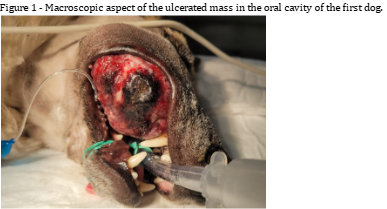Oral squamous cell carcinoma with bone invasion in two dogs - case report
DOI:
https://doi.org/10.21708/avb.2024.18.4.12652Resumo
Squamous cell carcinoma (SCC) is the third most prevalent tumor in the oral cavity of dogs with middle to advanced age. This report describes the cases of dogs aged 8 and 13 years. The first animal presented sialorrhea with blood, hyporexia, emaciation, hypocorned mucous membranes, enlarged right submandibular lymph node, and, in the oral cavity, intense halitosis and nodosity in the right maxillary antimer, which was friable, blackened, adhered, and hemorrhagic, starting in the soft palate and infiltrating the hard palate. There was hypochromic microcytic anemia with the presence of anisocytosis and Heinz corpuscles, as well as thrombocytopenia, macroplatelets, leukocytosis due to neutrophilia, monocytosis with the presence of toxic neutrophils, and hyperproteinemia with hypoalbuminemia, decreased ALT, and urea. The patient underwent surgery to remove the nodule but returned for euthanasia days later due to aggressive tumor recurrence. The second animal presented masticatory dysphagia, anorexia, hypocorned mucous membranes, capillary filling time greater than 2 seconds, blowing in the mitral and tricuspid valves, and firm elevation in the lower part of the right mandible in the caudal mentonian region. Additional tests showed erythrocytosis, polychromasia, thrombocytosis, platelet aggregation, macro platelets, and increased ALT. Ultrasound examination showed renal alterations compatible with senile degeneration and/or nephropathy, nodulations in the spleen, prostate, and left testicle, and enlargement of the right adrenal gland. Initial anti-inflammatory and analgesic treatment was instituted, but he died. Necropsy and the histopathological examination of the animals showed a diagnosis of SCC with bone invasion, the latter being an uncommon fact.
Downloads

Downloads
Publicado
Edição
Seção
Licença
Copyright (c) 2024 Acta Veterinaria Brasilica

Este trabalho está licenciado sob uma licença Creative Commons Attribution 4.0 International License.
Autores que publicam na Acta Veterinaria Brasilica concordam com os seguintes termos: a) Autores mantém os direitos autorais e concedem à revista o direito de primeira publicação, com o trabalho simultaneamente licenciado sob a Licença Creative Commons Attribution que permite o compartilhamento do trabalho com reconhecimento da autoria e publicação inicial nesta revista. b) Autores têm autorização para assumir contratos adicionais separadamente, para distribuição não-exclusiva da versão do trabalho publicada nesta revista (ex.: publicar em repositório institucional ou como capítulo de livro), com reconhecimento de autoria e publicação inicial nesta revista. c) Autores têm permissão e são estimulados a publicar e distribuir seu trabalho online (ex.: em repositórios institucionais ou na sua página pessoal) a qualquer ponto antes ou durante o processo editorial, já que isso pode gerar alterações produtivas, bem como aumentar o impacto e a citação do trabalho publicado (Veja O Efeito do Acesso Livre).


 Esta obra está licenciada com uma Licença
Esta obra está licenciada com uma Licença 